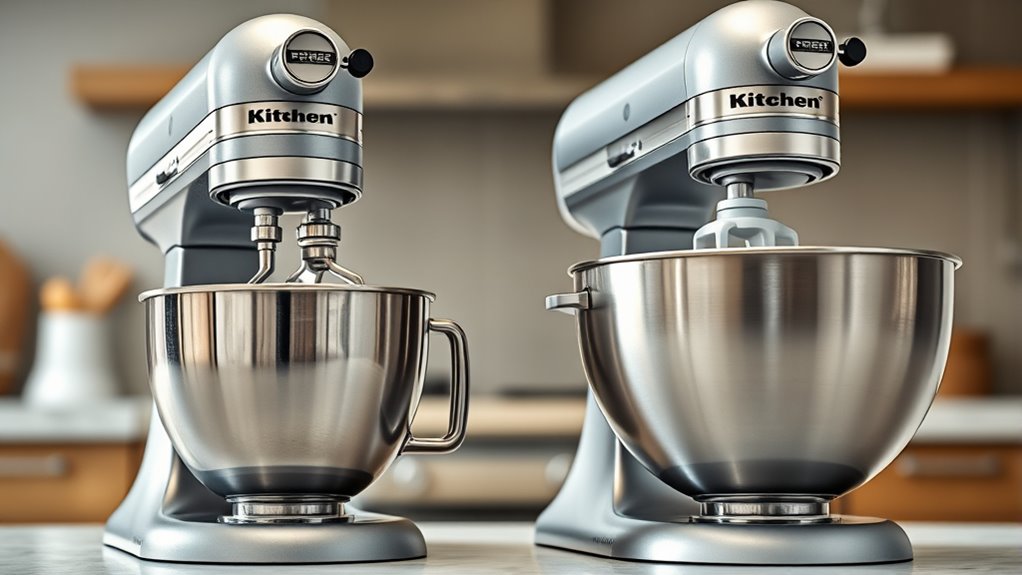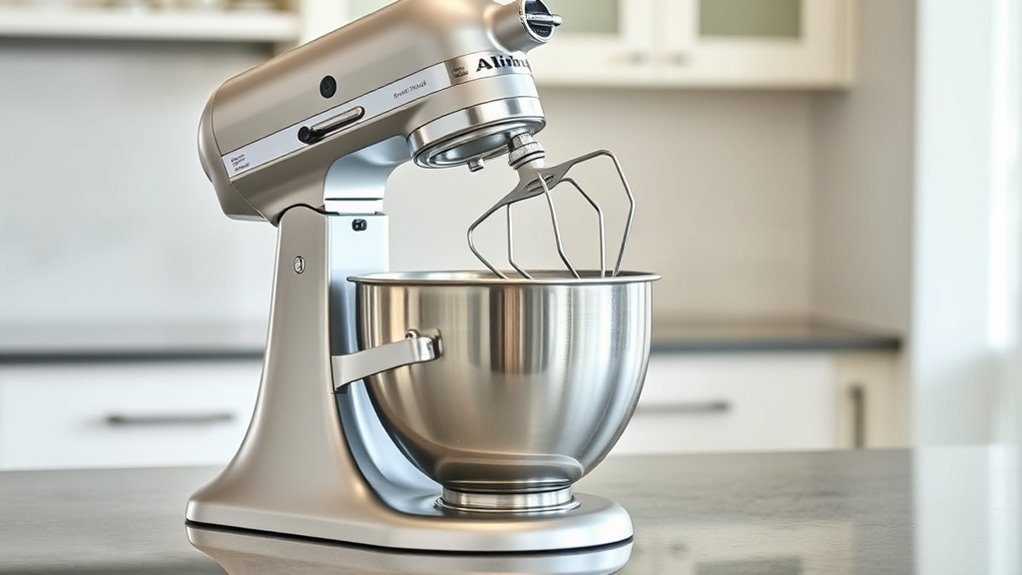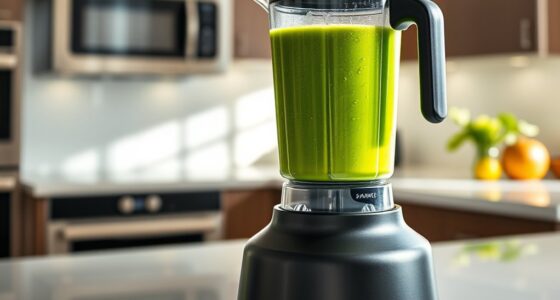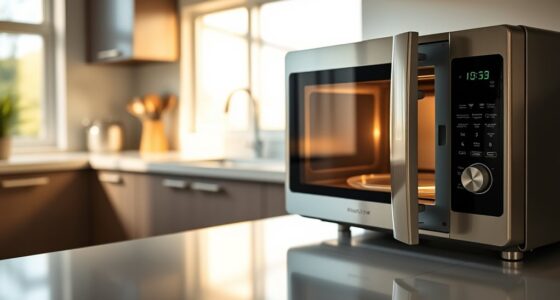Tilt-head mixers have a lighter, more compact design, making them easy to access and store, but they often have less powerful motors suited for lighter tasks. Bowl-lift mixers feature a sturdy mechanism that lifts the entire bowl, providing greater stability and handling heavier, denser ingredients. The engineering differences influence performance and longevity, with bowl-lift models ideal for demanding tasks. If you want to understand which design fits your needs best, there’s more to explore below.
Key Takeaways
- Bowl-lift mixers feature a sturdy mechanism that raises the entire bowl for stability during heavy-duty tasks.
- Tilt-head mixers have a tiltable head for easier access, simplifying ingredient addition and attachment changes.
- Bowl-lift models generally have higher wattage motors, enabling better handling of dense dough and demanding tasks.
- Tilt-head mixers are more compact and ergonomic, ideal for limited spaces and lighter baking needs.
- Engineering differences influence performance, workload capacity, user convenience, and long-term durability of each mixer type.

When choosing a stand mixer, understanding the differences between tilt-head and bowl-lift models is essential. These models are designed with distinct engineering features that influence how you operate them, how comfortable they are to use, and how effectively they perform. One of the key factors to consider is motor power. Tilt-head mixers typically have a motor that’s slightly less powerful compared to bowl-lift models, which are built for heavier, more demanding tasks. If you plan to knead dense bread dough or whip large batches regularly, opting for a bowl-lift model with higher motor wattage ensures you won’t strain the motor or compromise performance. Conversely, if your baking involves lighter tasks like whisking eggs or mixing cake batter, a tilt-head mixer with moderate motor power might suffice and offer a lighter footprint.
Ergonomic design also plays a significant role in your choice. Tilt-head mixers are celebrated for their user-friendly design, allowing you to tilt the head back easily to access the mixing bowl. This makes adding ingredients or changing attachments straightforward and quick. The ergonomic design of tilt-head models often means less physical effort when operating or cleaning the mixer, which is beneficial if you have limited strength or simply want convenience. On the other hand, bowl-lift mixers feature a sturdy lifting mechanism that raises the entire bowl to the mixing position. While this may require more effort initially, it provides stability during heavy mixing and reduces the risk of the bowl slipping or tipping over. The ergonomic advantage of a bowl-lift mixer lies in its ease of handling large, heavy bowls without requiring you to tilt or maneuver the mixer itself.
Both designs have their pros and cons rooted in their engineering. Tilt-head models are generally more compact, easier to store, and accessible for quick ingredient additions, making them ideal for home bakers with limited space. Bowl-lift mixers, however, are often more robust, designed for continuous, heavy-duty use, and better suited for professional kitchens or serious baking enthusiasts. When considering your specific needs—whether it’s frequent heavy kneading or occasional baking—you’ll want to evaluate how the motor power and ergonomic design align with your routines. Additionally, projector image quality can be affected by the engineering of the components, so choosing a mixer that matches your workload ensures better performance and longevity. Ultimately, understanding these engineering differences helps you choose a mixer that’s not only powerful enough for your tasks but also comfortable and efficient to use day after day.
Frequently Asked Questions
Which Mixer Type Is Better for Heavy Doughs?
For heavy doughs, a bowl-lift mixer is generally better. It offers superior dough handling and stability, making it easier to mix dense ingredients thoroughly. Its design enhances mixing efficiency by providing better access and more powerful motors, which handle tough doughs without strain. You’ll find it more reliable for continuous mixing, saving you time and effort while ensuring your dough is mixed evenly and thoroughly.
How Does Motor Power Differ Between Tilt-Head and Bowl-Lift Models?
You might think all mixers are similar, but the motor power tells a different story. Bowl-lift models often have higher motor capacity and power ratings, giving them the strength to handle heavy doughs effortlessly. Tilt-head mixers usually feature lower power ratings, making them less ideal for tough ingredients. So, if you need robust performance, pay close attention to the motor capacity—it’s the key to choosing the right mixer for demanding tasks.
Are There Differences in Noise Levels Between the Two Types?
You might notice noise level differences between tilt-head and bowl-lift mixers. Generally, tilt-head models tend to be quieter because their design allows for easier access and less mechanical complexity, reducing sound during operation. Bowl-lift mixers can be a bit louder due to their heavier motor and more robust construction. The noise comparison varies by brand and model, but overall, tilt-head mixers often have lower sound level differences, making them preferable if noise is a concern.
Which Mixer Type Is Easier to Clean and Maintain?
Did you know that 80% of users find tilt-head mixers easier to clean? You’ll appreciate that tilt-head mixers offer better ease of cleaning because their removable attachments and open design make wiping and access simpler. Bowl-lift models can be more challenging due to their enclosed structure and harder-to-reach areas. Overall, tilt-head mixers tend to have fewer maintenance challenges, saving you time and effort in the long run.
Do Price Points Significantly Vary Between Tilt-Head and Bowl-Lift Mixers?
You’ll find that price points do vary between tilt-head and bowl-lift mixers, often influenced by brand reputation and features. Generally, tilt-head models are more affordable, but premium brands can narrow the gap. Brand influence can markedly affect pricing variations, so it’s wise to compare options within your budget. Ultimately, choosing based on your needs and budget will help you find the best mixer without overspending.
Conclusion
Think of tilt-head and bowl-lift mixers as different ships steering the same ocean. The tilt-head is like a swift sailboat, easy to maneuver and perfect for quick tasks, while the bowl-lift is a sturdy cargo ship, built to handle heavy loads and long journeys. Choosing between them depends on your voyage—speed or strength. Remember, your kitchen’s success hinges on selecting the right vessel to steer your culinary adventures smoothly.









